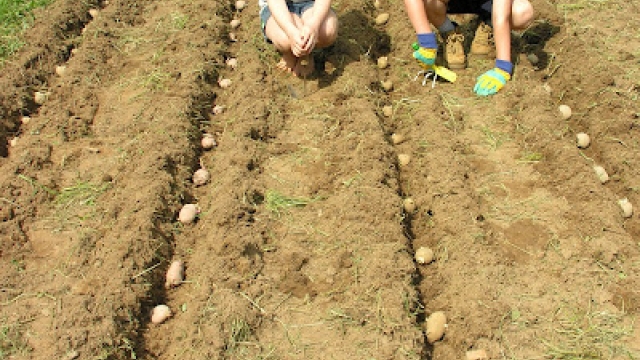Potato planting is a fascinating and rewarding endeavor that holds the key to a bountiful harvest. Whether you’re a seasoned gardener or a novice with a green thumb, understanding the secrets of successful potato planting is essential to unlock the full potential of these versatile tubers. From selecting the right seed potatoes to choosing the ideal planting location, every step in the process plays a crucial role in ensuring robust growth and abundant yields.
One of the fundamental aspects of potato planting involves understanding the ideal conditions for these underground gems to thrive. Potatoes are a cool-season crop, best suited for planting when the soil temperature reaches around 45 to 55 degrees Fahrenheit. This typically corresponds to early spring in most regions, providing the perfect window of opportunity to kickstart their growth. By planting at the right time, you set the stage for healthy, vigorous plants that will produce an abundance of tasty spuds.
Choosing the Right Potato Varieties
When it comes to potato planting, selecting the right potato varieties is crucial to ensure a successful and bountiful harvest. There are numerous potato varieties available, each with its own unique characteristics and suitability to different growing conditions and culinary uses.
- Consider Environmental Factors:
The first factor to consider when choosing potato varieties for planting is the environmental conditions of your region. Some potato varieties thrive in cool climates, while others are more tolerant of warmer temperatures. Additionally, certain potato varieties are resistant to common diseases, such as blight, and can be a wise choice if your area is prone to these issues.
- Determine Culinary Uses:
Another important aspect to consider is the intended culinary use of the potatoes. Different potato varieties have varying textures, flavors, and cooking qualities, making some more suitable for specific dishes. For example, waxy potatoes are ideal for salads, while floury potatoes are better for baking or mashing. Research the characteristics of each variety to match them with your cooking preferences.
- Companion Planting:
Lastly, for those looking to maximize their potato planting efforts, consider companion planting. Some plants have been found to be beneficial when grown alongside potatoes, either by repelling pests or improving soil conditions. Research and identify companion plants that can contribute to the overall success of your potato crop.
By carefully selecting the right potato varieties based on environmental factors, culinary uses, and potentially incorporating companion planting, you can set yourself up for a productive and rewarding potato planting experience.
Companion Plants for Successful Potato Growth
When it comes to planting potatoes, choosing the right companion plants can greatly enhance their growth and productivity. By strategically selecting plants that complement potatoes, you can create a favorable environment that encourages healthy development and deters pests. Here are three excellent companion plants to consider for successful potato growing:
-
Marigolds: Marigolds are renowned for their ability to repel pests, making them an ideal companion for potatoes. Their strong scent helps deter insects, such as aphids and nematodes, which can harm potato plants. Planting marigolds around your potato patch acts as a natural pest control method, reducing the chances of infestation and increasing your potato yield.
-
Horseradish: Horseradish is not only a delicious addition to meals but also a fantastic companion plant for potatoes. The pungent aroma of horseradish acts as a natural deterrent for pests like Colorado potato beetles. Planting horseradish near your potato plants can help keep these pests at bay while providing a zesty flavor to your culinary endeavors.
-
Beans: Beans are known for their nitrogen-fixing properties, making them an excellent companion plant for potatoes. As legumes, beans have a symbiotic relationship with certain bacteria that enriches the soil with nitrogen. Potatoes, in turn, benefit from this increased nitrogen availability, leading to healthier foliage and improved tuber production. Consider interspersing bean plants with your potatoes to help create a nutrient-rich environment.
By incorporating marigolds, horseradish, and beans as companion plants for your potato patch, you can promote successful growth while naturally combating pests and enriching the soil. These companions not only contribute to a thriving potato garden but also provide additional benefits for your culinary pursuits.
Best Practices for Planting and Caring for Potatoes
-
Soil Preparation:
Before planting potatoes, it is essential to prepare the soil properly. Start by selecting a well-drained location that receives ample sunlight. Removing any weeds or grass from the area is crucial to ensure that the potatoes do not compete for nutrients. Loosen the soil and remove any rocks or debris to create a smooth and fertile bed for planting. -
Planting Techniques:
To achieve successful potato planting, there are a few key techniques to keep in mind. Begin by cutting certified seed potatoes into chunks, making sure each piece has at least two eyes or sprouts. Dig shallow trenches, around 4-6 inches deep, and place the seed potatoes inside, spacing them about 12 inches apart. Cover the planted potatoes with soil, leaving a slight mound on top to promote drainage. - Kellogg Garden Organics Mulch
Companion Plants for Potatoes:
Potatoes can benefit from certain companion plants that aid in warding off pests and improving overall growth. Marigolds, for example, release a chemical that repels harmful pests like aphids and nematodes. Beans, peas, and corn also make great companions for potatoes as they help fix nitrogen in the soil, which is beneficial for the potato plants. However, it is important to avoid planting potatoes near other nightshade family members, such as tomatoes, peppers, and eggplants, as they can be susceptible to similar diseases.
Remember that consistent care and attention are vital for successful potato growth. Regularly check for signs of disease or pests and take appropriate measures to prevent and control them. Water the potatoes adequately, ensuring that the soil remains moist but not waterlogged. By following these best practices, you can maximize your potato yield and enjoy a bountiful harvest.
